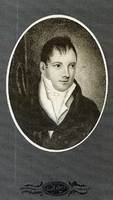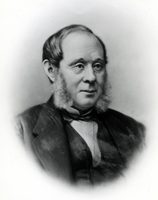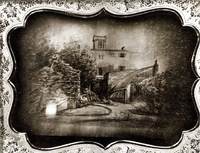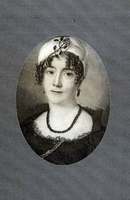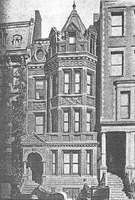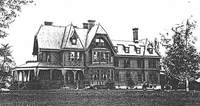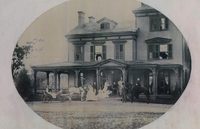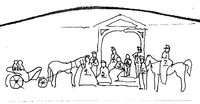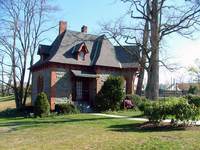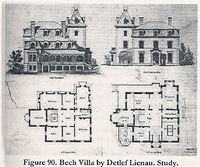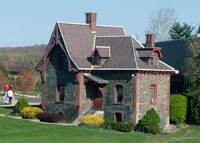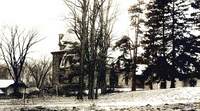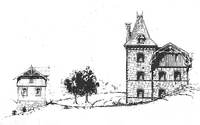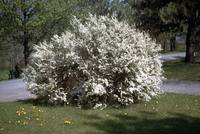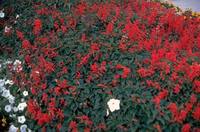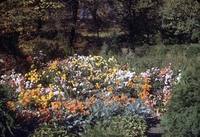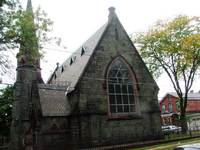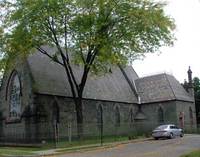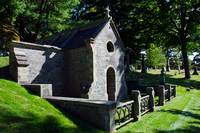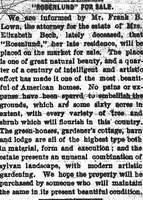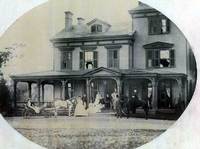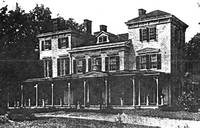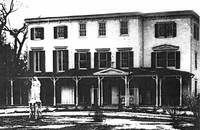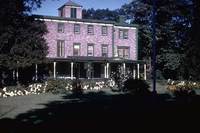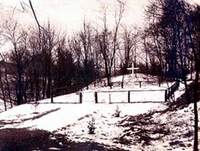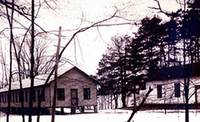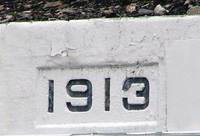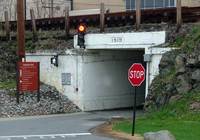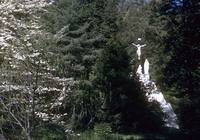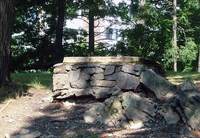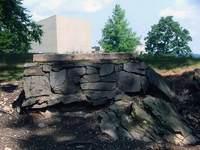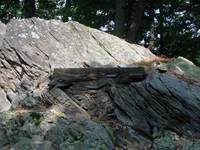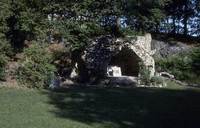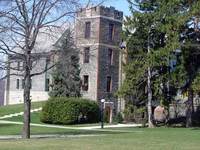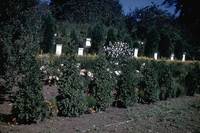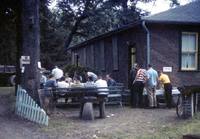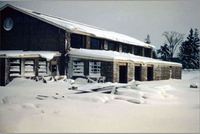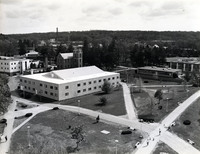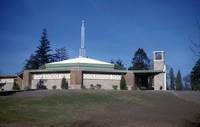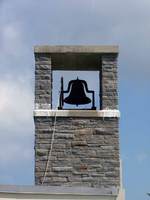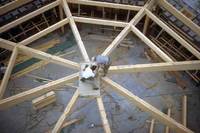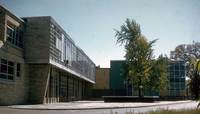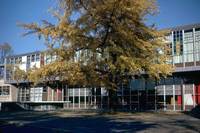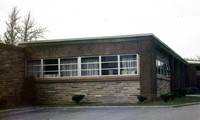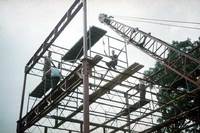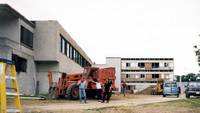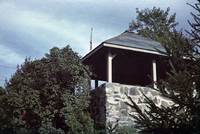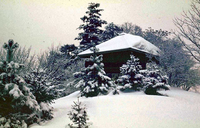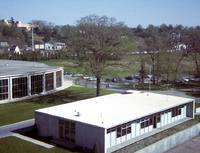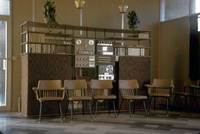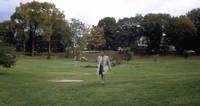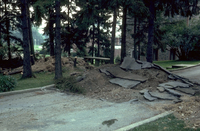Rosenlund (Edvard Bech Estate) also known as the Novitiate
The Bech parcel refers to the Marist College campus section just south of the WaterWorks Road (see note 1). Called Hickory Grove by previous owners, the Bechs renamed it Rosenlund; it consisted of five parcels pieced together between 1863 and 1868 (see note 2) Brother Louis Zephiriny purchased it in his own name and then transferred it to the Marist Brothers (see note 3).
The land extends south to the entrance plaza to the McCann Athletic Center. Situated on the Bech parcel are: Our Lady Seat of Wisdom Chapel, Greystone, Donnelly Hall, the Cannavino Library, Sheahan Hall dormitory, Leo Hall Dormitory, the Champagnat Hall dormitory and student center, the mid-rise dormitory, the Tenney Athletic complex, the Kieran Brennan Gatehouse, and St. Peters Building and most of the Gartland Baseball field.
The Bech parcel is bordered on the south by the Myers parcel which contains the McCann Athletic Center and on the north by the Barnard parcel.
Click here to read Bech Homestead & Family History by Dr. Brian Henry Desilets
Owners before the Bech family
Landowners listed in the 1848 Hudson River Railroad map
The Hudson River Railroad Company filed a map with the county that listed each current landowner and the length of land above high water and separately the length of land below high water (if any) for each owner. This gives us a good benchmark as to the size of the parcels held by the owners. The lengths can be measured from the south edge of the Waterworks Road as it exists near the route nine highway (the bend in the road as it approaches the railroad tracks came about after several parcels were taken to build or enlarge the water works.) The owners, from north south were
|
Owners |
from north to south |
|
Length of track |
in feet |
|
Mrs. Sarah Van Anden (widow of Abraham van Anden) |
328 |
|
Jahiel and Phebe Smith |
324 |
|
William Davies |
603 |
|
George F Tallman |
1449 |
The Tallman holding extended down to Hoffman Street. Its northern section became the Henry D Myers lot, 10.4 acres of which was purchased by Marist College in 1963.
On August 16, 2012 I attempted to lay out the boundaries of the Van Anden, Smith and Davies parcels. As rough estimates, the Van Anden lot reached from the Waterworks Road south to the end of the Cannavino Library, but not to the Greystone building. The Smith parcel ran to the south end of the Donnelly building. The Davies parcel ran at least to the road turning off the main road to the McCann parking lot. This is very rough reckoning, as the east/west boundary lines of the parcels do not run parallel. However, it seems most likely that the old house occupied by the Bechs until 1900 and by David Bartlett before then was located on the Davies parcel (see note 4).
Abraham Van Anden and Family
The first deed of land directly to Abraham Van Anden is from Rhoda Dunning née Van Kleeck (see note 5). Her father was Baltus Van Kleeck, who had moved down to Poughkeepsie from Albany shortly after the award of the Hermanse and Sanders patent. He adopted the surname Van Kleeck after his home town in the Netherlands, and is considered one of the founders of modern Poughkeepsie. He held land mostly north of today’s Main Street, and willed several parcels in the Marist College area to his children, including Rhoda. Rhoda’s first marriage to Nathaniel Quimby ended in divorce. She later married a Dunning and relocated to Newburgh. At that time she disposed of several parcels which had been willed to her by her father. She sold a 12 acre parcel in the Town of Poughkeepsie to William Davies, who was very active in real estate (see note 6). To do this she needed the permission of her former husband (see note 7 ). William and Polly Davies then sold the acres to Abraham Van Anden, who added pieces to his farm on several occasions (see note 8).
The deed to the Barnard parcel describes it as lying just above that of Van Anden. Another deed in 1872 the Water Commissioners of the City of Poughkeepsie taking land for access to the main highway described the land as from the Barnard property just along the Van Anden boundary. This became the WaterWorks Road familiar to us and still a major east–west link within the Marist College holdings.
Jehiel and Phebe Smith
Jehiel Smith purchased a farm from John Hustis in 1835. Hustis had purchased the farm from William Davies in 1805. The railroad took land when the Smiths owned the farm. In 1857 Jehiel and Phebe sold the farm to William and Thomas Davies (see note 9).
David Ely Bartlett (1806 – 1879)
The first school operated on Marist College land was not that operated by the Marist Brothers, but a school for the deaf operated by David Ely Bartlett and his wife Fanny Pomeroy from 1852 to 1860. The Bartlett family lived in what became the Marist Brothers Novitiate building on a site just across the road from the southern end of Tenney Stadium. The couple accepted as students youngsters deemed not old enough to be admitted to schools for the deaf. David contended that education for deaf children ought to begin much earlier than the 12 or 13 year standard in other schools for the deaf (see note 10).
David’s father was Reverend Shubael Bartlett (2 April 1776- 6 June 1854) an 1800 graduate of Yale His grandfather, John Bartlett, was deacon in the Congregational Church of Lebanon CT, under the pastoral charge of Rev. Dr. Ely (that explains the Ely!) His grandfather traced roots back to John Alden. One of his brothers, Shubael Fitch Bartlett (1811 – 1849) also graduated from Yale and taught several years in a school for deaf mutes. He then turned to medicine. At the time of the gold strike in California, he left the East to minister to those who moved to California. Sadly he caught dysentery and died 12 October 1849 before he could return to Connecticut.
David Bartlett continues to be recognized for his innovative ideas and superb work in educating the deaf (see note 12).
The Bechs
Edvard and Elizabeth McCarty Bech owned the Bech parcel from their purchase to its sale to Marist Brother Louis Zephiriny (see note 13).
Edvard Bech died in 1873 and Elizabeth in 1900, She left the estate to Pauline E Braëm de Neuerdorff, her granddaughter and the daughter of her son Henry Braëm, who had died before Elizabeth Bech. A study of the papers on file in the Surrogate’s Court of Dutchess County reveals that two of Elizabeth’s daughters living in Europe and one Henry Braëm’s sons contested the will, and it took until 1905 to have the estate settled. The sale to Nicholas Jungeblut was probably a mechanism to clarify the award to Pauline and to facilitate any sale to a future bidder.
Edvard Bech (4 May 1812 – 1873) (see note 14).
Edvard Bech was born 4 May 1812 the son of a prosperous Copenhagen merchant, Jorgen Bech. The Bech family lived south of Copenhagen, near the German border. The territory was later absorbed into Germany. Edvard studied for some years in Berlin. Edward immigrated to New York in 1838 (see note 15).
While in New York Edward Bech became the Danish Consul in New York. He lived in Manhattan (see note 16). He became a trader in wine and iron. Through his interest in wine, he became acquainted with Michael Lienau, also in the wine trade. The two gentlemen served together on several boards and committees. Through his work with iron, he became acquainted with Joseph Tuckerman; the men joined together to acquire an iron foundry located at the foot of Union Street in Poughkeepsie NY.
Joseph Tuckerman was the son of a New England clergyman. He came to New York City and seemed to have lived in the city permanently. He introduced Bech to the iron business and Bech joined with Tuckerman on several joint ventures in the mid-Hudson area (see note 17).
On the death of his father Jorgen Bech in 1853, Edward inherited money which he used to invest in the Poughkeepsie Iron Company. Eventually he bought out Tuckerman’s share in the operation and purchased another site along the Hudson River north of Hoffman Street and just south of the Marist College property. The new site was larger and provided greater capability to produce pig iron – initially refined iron which would then be sold to other foundries that would make specialized iron and steel using more sophisticated refining and additives.
The Hudson shoreline became a favorite place for the iron industry. Originally the furnaces were fueled by charcoal, but with the completion of the Delaware and Hudson Canal, the foundry switched to regular coal from Pennsylvania.
Almost any dirt contains some iron, but the trick is to find enough iron to justify the refining process. Bech obtained most of his iron from beds in Beekman and Fishkill, in southeast Dutchess County (see note 18). The regular means of transportation was by ox cart (oftentimes by plank roads during rainy weather, as railroad transportation was not available (see note 19). Bech purchased some land in Fishkill and Beekman, and purchased ore rights in other properties (see notes 20-21). Bech also invested in ore deposits around Lake Champlain, which were transported by barge through the Champlain Canal (opened in 1923, about the same time as the Erie Canal.) The Champlain ore was reputed to be the purest in the world, comparable to that found in Sweden.
One advantage of concentrating on pig iron was that the furnaces could be operated year round, and the pig iron stored on site. Sales of pig iron might be concentrated in some seasons of the year. But the Iron Works could maintain a constant workforce and keep its furnaces busy the whole year.
Edward Bech decided to relocate from New York City to Poughkeepsie. He purchased a house on Market Street, just opposite the current Court House and moved his family there. The house was convenient to supervise the operation at the original Union Street landing (see note 22). After he decided to move the major foundry to the Hoffman Street site, he purchased a nearby estate called “Hickory Grove” which had been the farm of Abraham Van Anden (see note 23).
Elizabeth McCarty Bech (1816-1890)
Edward Bech’s wife goes by different names in documents. She usually used the name Elizabeth McCarty Bech in purchases and sales of property and applications for passports, etc. V. A. Buechele indicates her maiden name was Charlotte Hossack and that she was born in 1812, the same year as Edward Bech. Her passport application in 1874 she states she was born in New York City 16 June 1816. The census record for 1860 indicates she is six years younger than Edward Bech, and the Braëm family listing says she was born 2 March 1808. The statistics don’t jibe, but these records are consistent enough to place her slightly younger than Edward (see note 24).
We have no knowledge why Elizabeth used that name instead of Charlotte nor where the McCarty name comes from. There was a Bavarian Princess Elizabeth Charlotte of Bavaria (1662 – 1722) but I could find no other connection to the names. Elizabeth was married previously to Rudolph Gothard Sighart Braëm (born 23 Dec 1801 died 15 Oct 1838 in NYC) and bore him two sons:, Henri Monod Braëm and Frederick August Braem (see note 25). Henri does not seem to have lived with the Bechs in Poughkeepsie, but his name appears later. Henri M Braem had two daughters: Pauline Emily, who inherited the Bech estate in Poughkeepsie and Josephine Elizabeth, who is a beneficiary in the Elizabeth McCarty Bech will.
Another unusual aspect of the Bech marriage is that several purchases to add land to the original Clegg/Bech purchase were concluded under the name of Elizabeth McCarty Bech. Normally the purchases were made by the male partner in the marriage. Perhaps Elizabeth had resources of her own (see note 26).
Rosenlund
After purchasing Hickory Grove, Edward Bech renamed it Rosenlund and set about to develop an estate in the grand manner of so many others, including Locust Grove (Samuel F B Morse), Woodcliffe (John Flack Winslow) and Springside (Matthew Vassar). To design this he turned to a young Danish architect, Detlef Lienau, the younger brother of Bech’s wine trading friend, Michael Lienau. Michael worked in Manhattan, but decided to live in Jersey City. His brother Detlef immigrated to New York in 1848 See note 27 Michael Lienau commissioned his younger brother to build a home in Jersey City. Detlef was somewhat conservative in style, preferring to design stone houses rather than the wood homes becoming prevalent in the early Victorian age.
Edward and Elizabeth Bech’s son, Edward Michael Bech died in 1862. His father commissioned Detlef Lienau to design a mausoleum for the Poughkeepsie Rural Cemetery, which later became the final resting place for Edward and Elizabeth, their son George A Bech and his wife Mary Stevens Strong Bech (1855-1880) who died in childbirth. Also buried in the mausoleum are George and Mary's son Edward Henri Peter Bech, as well as Elizabeth’s mother Margaret Hossack (see note 28).
The architect designed a general plan for the estate. Three major buildings were constructed before any work started on the main residence. The Bech’s stayed in their house in Market Street, and after 1863 occupied the former Van Anden/Bartlett house at the southern end of the property. Detlef designed a gatehouse, a gardener’s cottage, a carriage house and a stable. The first two buildings are essentially the same as first designed, (except for electricity and plumbing). The carriage house (now called Greystone) was designed with the ground floor as a blacksmith’s shop, the main floor as the carriage room, and an upper floor as a storage room for hay. Early photos show a large wooden building just west of the carriage house, probably used as workshop and housing for employees. The stable was designed as a similar stone building just north of and below the hill from the carriage house. However, photos indicate that it was constructed as a wooden building. Presumably the northern part of the property was designed to be the working farm, with the eventual main house at the southern section.
The Bechs moved from 57 Market Street into the Bartlett house shortly after the purchase of the property in 1863 (see note 29). A group photo of the family was posed in front of the Bartlett building, which shows a single tower at the northern end of the front façade. A similar tower was added at the southern end soon to accommodate the Bech family.
Edmund Platt indicated that the local iron industry went through a contraction caused by the “failure of Edward Bech” which caused him to take in partners. This statement is questionable; it may have been Bech’s intention to take in partners all along. Early on he had hired Albert E Tower as his superintendent. Unlike Bech who discovered iron manufacture as a result of his trading experience, Albert Tower worked in several different foundries in the East Coast, and was more proficient in the nuts and bolts of manufacturing pig iron
Bech did suffer reverses during the Panic of '57; he had invested heavily in the Cunard Line which went into bankruptcy. The notes by Viggo Bech Rambusch in the Bech Collection in the Marist College Library archives indicate that Edward managed to pay off all his creditors within eight months of his reverses. It is also noted in the Bech Collection files that Bech, his wife Elizabeth and their children spent almost a full year in Denmark around 1857-1858. He may have enlisted the financial support of relatives in Germany and Denmark. There is later correspondence under the signature of Henri Monad Braem concerning stock owned by relatives in the Port Henry Iron Company, which company remained very profitable during the turndown.
Albert Tower joined the operation possessing considerable assets from his prior work. The county records show at least twenty real estate purchases or leases between 1856 and Edward Bech’s death in 1873. Not all these were from Bech, but they are related to the industry and include purchases and leases.
In 1875, after Edward Bech’s death, Elizabeth McCarty Bech, acting as executrix of Edward’s will sold his half of the company to the Poughkeepsie Iron Works. At the same time Albert Tower sold his half of the company to the Poughkeepsie Iron Works. Tower was the major stockholder in the Iron Works (see note 30).
Detlef Lienau, Architect (1818-1887)
Although Detlef Lienau was one of the founders of the American Institute of Architects, he had been all but forgotten until recent publication of Ellen Weill Kramer’s 1956 doctoral thesis. He was born in Utersen, thirty miles north of Hamburg in the Duchy of Holstein, which was then nominally a Danish holding. He was educated largely in Germany. He completed his work at the local trade school in 1837 and did a three-year apprenticeship under master carpenters in Berlin. This was followed by apprenticeships in Hamburg and Munich. This provided a thorough grounding in the design and construction of buildings of stone and wood common in northern Germany.
By May 1842, Lienau was in Paris, studying in the atelier of Henri Labrouste from 1842 through 1846. Labrouste was a graduate of the Ēcole des Beaux Arts, but broke away from the rigid adherence to classical forms emphasized by the Ēcole. He attracted students who were willing to experiment and try new things. After five years Detlef was able to sign his name “Lienau, archte” He took employment with the Paris- to-Lyons Railroad (see note 31). The railroads were proving receptive to new ideas and new materials available to construction. Detlef may also have spent some time in England. He decided to come to America. Detlef Lienau’s first commission came from his brother Michael, to design a cottage for the Lienau family in Jersey City. More important, Michael introduced Detlef to a wide variety of individuals who were in positions to commission architectural work.
The first major project was for Mr. M. Schiff, a Frenchman from New Orleans. The house was located at Fifth Avenue and Tenth Street, just across from the newly constructed Ascension Church (see note 32). (Detlef also designed the burial vault for M Schiff in Greenwood Cemetery). Lienau designed a Mansard roof for the Schiff house, and produced detailed drawings to show the carpenters how to construct the roof. This is the first known use of the Mansard roof in the United States.
Lienau went on to design private residences (notably the Lockwood Mansion in Norwalk CT, the largest private residence he designed), apartment houses, industrial buildings and row houses, He did not insist on a specific style, but adapted the design to the function and site. However, his first love was the German/Danish brick and stone style rather than the Victorian wooden structures coming into vogue during the third quarter of the 19th century.
His last project was to design the row of four houses at 48-54 West 82nd Street, built for members of the Lienau and Williams family. Up to this time Lienau had lived in Jersey City. He moved into No. 48 of the houses on West 82nd Street. Within a few months, he died of typhoid fever on August 29, 1887.
Edward Bech died in Stuggart, Germany on 9 July 1873, from consumption. He may have traveled to Europe to escape the atmosphere of the furnaces. A search of travel, passport applications and ship manifests show that he and the family traveled often to Europe, sometimes together, more often separately. At the time of his death he was President of the Port Henry Iron Company of Lake Champlain and senior member of the firm of Edward Bech & Co of New York City. The Port Henry firm continued in existence until the 1890s, and the Edward Bech trading firm was in existence until the death of George A Bech in 1890.
The Gindra Family
Rosenlund was noted for its beautiful gardens and landscaping. This was in large measure the work of David Gindra (1832 – 1908), the head gardener and a prominent member of the Dutchess Horticultural Society. David arrived in New York from Bremen Germany on 5 July 1854. The passenger list describes him as 21 years old and a ‘minor’. The 1860 census for Roxbury MA shows him working for and living with the family of Martin Trautman, florist. By 1870 David Gindra was living in Poughkeepsie, with his wife Bertha (also born in Germany) and three children Conrad, age 9 (born in Massachusetts) David, age 6, and Paul, age 3 (both born in New York) (see note 33).
David Gindra’s obituary indicated that he spent 45 years on the Bech estate. He was often called out of town to consult with men of wealth having beautiful places because of his original ideas in arranging flowers. His sons Conrad (1861 – 1933) and Paul (1867 – 1929) worked on the Bech estate with their father, and they learned the business well.
Conrad purchased the Fricker greenhouses along Main Street in the Arlington district, and he and his wife Margaret built a home on Spoor Avenue off Hooker Avenue. Paul and his wife Cora remained on Delafield. Both boys were florists and landscapers (see note 34).
The author of the Annals of St Ann’s Hermitage described the Bech property after the purchase by the Marist Brothers (page 11): “Having been abandoned for several years, its looks were not prepossessing. However, when we strolled along its wide roads we could see beautiful groves, a large number of trees of various species, and several varieties of plants growing here and there. We could also see remains of spacious greenhouses in different places, some indication of what the property must have been at one time .“
The southern section of the estate, close to the main house, seems to have been reserved for a garden and the northern section for a farm. When I lived in the main house 1945-1947, there were vestiges of beautiful plantings, which we mistakenly attributed to the rural backgrounds of the Brothers from Canada and France. In retrospect, the Brothers built on the base developed by the Gindras. The 1880 farm census reported 20 acres tilled, 40 acres woodland, 15 acres mown for hay, and eight horses on the property. It also reported three milking cows which provided 300 pounds of butter each year and 25 chickens which produced 150 dozen eggs.
George Albert Bech (1856-1890)
George Albert Bech was 17 when his father Edward Bech died in 1873. His two older sisters had married and were living overseas in Austria. His older brother, Edward Micvael Hossack Bech (1851-1962) had died and was buried in the family mausoleum in Poughkeepsie Rural Cemetery (designed by Detlef Lienau). George married Mary Stevens Strong 17 April 1879 at Trinity Church, NYC. Mary died in childbirth for their son Edward Henri Peter Bech who is also buried in the Mausoleum. He appears in the 1880 census with his mother Elizabeth, a ladies maid, a cook, a coachman, and the Gindra family.
On July 29, 1886 a new steel steam yacht, the Dagmar, was successfully launched at Newburg. It was built for Mr. George A Bech of Poughkeepsie. The launch was watched by, among others, Mr. Bech and Mr. Newbold of Poughkeepsie, from the deck of the Marina, another steam yacht owned by George A Bech (see note 38). The Dagmar was to be schooner rigged, of overall length 121; length at the water line 98 feet. A subsequent article in the New York Times described a 16 mile trial trip run at reduced speed (see note 39). On board passengers included F. Newbold, Conrad Gindra and Paul Gindra. The following Saturday Mr. Bech was to take a party of friends on an Eastern cruise, going first to Mount Desert (see note 40).
On 15 December 1881 George Bech paid $38,000 for 372 acres lying across route nine (see note 41). He may have added farmland to the Rosenlund estate. The land was available in 1905 when Brother Louis Zephriny acted for the Marist Brothers (see note 42).
George Bech remarried on 17 Feb 1887 to Julia May of Baltimore. The wedding announcement in the New York Times described George Bech as formerly of Poughkeepsie, but now of New York, where he is a well-known club man. The bride was attended by the “little Misses Braëms, of New York.” These were Pauline and Josephine, both whom later married and lived overseas. Among those Poughkeepsie citizens present at the wedding from Poughkeepsie were his mother, Elizabeth Bech, Mr.& Mrs. Henri Braëm, Mr. Newbold, Mr. Newbold, and Mr. & Mrs. R. Roosevelt. George was very friendly with the Newbolds and Henri Braëm was George’s half-brother, both having Elizabeth Bech as their mother.
George Bech and his wife Julia resided at Rosenlund, but wintered in the Baltimore/Washington area, bringing Elizabeth Bech with them to avoid the very cold winters in the Hudson Valley. They were preparing to return to Rosenlund 17 April 1890 when George was struck with apoplexy (probably a stroke) and died at his Washington residence. The funeral was held 19 April at Holy Comforter church, where the Bechs had been parishioners and George had given generous support, with burial in the Bech vault in Poughkeepsie Rural Cemetery.
George died intestate, which complicated settlement, as persons of interest resided mostly in Europe. His wife Julia handled the estate, which exclusive of real estate amounted to $98,660. One half was awarded to his widow, and one eighth to each of: his mother Elizabeth Bech, his half-brother Henri Braëm, his sister Sophie of Denmark and his sister Marie of Stuttgart, Germany. Newspaper accounts indicate that he had inherited a private fortune of considerable proportions. Although he must have been the principal support of Rosenlund, the estate was in Elizabeth Bech’s name.
George Bech also owned property in Stock bridge MA, of which Julia took possession; The Stockbridge property was called Edgehill.
Disposition of Rosenlund
After George Bech died, Julia May Bech married William Babcock and moved away from Rosenlund. Elizabeth Bech lived alone there until her death on 29 May 1900. She had been in failing health for several years.
Elizabeth left a will which she made in her own handwriting in 1886, and added two codicils, one after the death of her son George in 1890 and the other after the death of her son Henri Monad Braëm in February 1900. Her estate was not extremely large, with personal property less than $25,000; her only real estate was Rosenlund. When her husband died, he left an estate worth $1.3 million, giving one third to his son George Albert Bech, and 1/9 each to his daughters. The remaining third he left in trust for his wife Elizabeth from which she received annually about $25,000. Her obituary notes that much of this annual receipt had been used for objects of charity. Like her son, Elizabeth Bech was buried in the Bech vault in Poughkeepsie Rural cemetery with the funeral service from Holy Comforter church, which church received $1,000 in her will (see note 35).
The most important asset, Rosenlund, Elizabeth left to her granddaughter, Pauline Braëm Von Nauerdorff, a resident of Vienna, Austria. Since most of the persons of interest for the will lived in Europe, there was delay in settling the estate. It was only in 1905 that Pauline von Nauerdorff transferred the estate to Nicholas Jungeblut of Minnesota (see note 36). This was probably a legal device to simplify sale of the estate, since Pauline had no intention of leaving her residence in Vienna.
Brother Louis Zephiriny purchased Rosenlund property from Jungeblut, using a mortgage to his sister Louise Merrillon, and immediately transferred both the MacPherson parcel and the Bech parcel to the Marist Brothers (see note 37).
Rosenlund remained in the Bech family for 37 years. The only longer owner before Marist College was the Marist Brothers, to which we turn now. But before we move there, we cite Brother Louis Zephiriny, who owned the MacPherson estate for three years and the Bech estate for one day!
Brother Louis Zephiriny (1861 – 1927)
François Adophe Louis Brochier was born in Lyons, Francs in 1861. He entered the Marist Brothers, completing his Novitiate in 1878. He spent one year as a cook, then as auxiliary teacher from 1879-1888, at the termination of which he had completed his Brevet complet which authorized him to teach any primary grades. His superiors recognized his administrative ability and planned to send him to North America for service with the United States and Canadian Brothers. But first they sent him to England for a year to learn English (see note 48).
When he arrived in New York City, he joined the Brothers community at St. Jean Baptiste, who were teaching at the St. Jean grammar school. The pastor asked the Brothers to begin a boarding school and Zephiriny started St. Ann’s Academy along 76th Street in 1892 (see note 49).
In 1904 the Provincial asked Zephiriny to explore possibilities along the Hudson River, and he found the MacPherson and Bech estates. He later became provincial of the province, a position he had to resign due to failing health. He returned to Poughkeepsie to teach in the Novitiate and give some college courses under the aegis of Fordham University, then lived in the infirmary until his death.
What distinguished Brother Zephiriny was his ability to make contacts with influential people. He made contacts with Cuodert Brothers, then at its zenith as a firm specializing in international law. The firm catered to large corporations and affluent individuals, yet assigned Mr. Murray to work with Zephiriny on what might be considered miniscule affairs such as land purchases in Poughkeepsie, and a mortgage for $26,000 to Zephiriny’s sister’s estate (Frederic Coudert, founder of the firm agreed to act as trustee). Later the firm represented the Brothers in an action against William Knauss who operated a slaughter house whose effluent was affecting the wells on the Poughkeepsie properties. Zephiriny managed to meet with President Theodore Roosevelt when customs held up delivery of a statue of the Blessed Mother destined for St. Ann’s Hermitage (see note 50). Zephiriny also was acquainted with the US heads of the Redemptorist Fathers and the Jesuits, the latter being helpful in establishing the Poughkeepsie operation.
Zephiriny loved literature. He wrote poetry in English and French, and authored hymns – both lyrics and melodies.
Although he did not live to see the establishment of Marist Training School or Marist College, he deserves to be remembered as a vital component of the development of both institutions.
The Marist Brothers era (1908 – 1961)
Rosenlund had been a beautiful estate in its prime, but it lost the support of George Bech in 1890 and Elizabeth Bech had limited funds to maintain the property in its original condition. She was ailing the last five years before she died. After her death, the determination of ownership of Pauline Van Nauerdorff was not settled until court action in 1905. David Gindra and his wife lived in the Rosenlund gatehouse until his death in 1908. When the Brothers acquired the estate in mid-1908 they found it overgrown, but under the overgrowth they discovered excellent plantings and also several greenhouses. The writer of the Annals of St. Ann’s Hermitage concluded that Rosenlund was in much better shape than the MacPherson estate which the Brothers had purchased in 1905.
The Rosenlund purchase enabled the Brothers to expand their activity into some well-defined areas. The southern zone containing the Bech house became the Novitiate and the northern area, including Greystone, the gardener’s cottage and the gate house developed into the Scholasticate or post Novitiate training center. The Barnard/MacPherson property remained the Juniorate, Provincial House, and farm center (see note 51).
The first phase of Marist Brothers’ ownership may be considered the years from 1908 to 1920, which were used to develop both the MacPherson and Bech properties for use as training centers for the Brothers. The second phase 1920 to 1942 would be characterized by development of college level courses under the aegis of Marist Training School supported by Fordham University. The third phase would be transition into a bachelor degree granting college, a transition spearheaded by Brother Paul Ambrose Fontaine (see note 52).
To develop the Bech House for Novitiate use, modifications had to be made. The Postulants and novices moved in on 25 September 1908. The dormitories and classrooms were ready, but not until December was the heating system satisfactory. A small room on the second floor served as a chapel, with Mass once weekly; the other days the faculty and students walked to the Juniorate in the MacPherson building for religious services.
1909 By June 14, 1909 a steam laundry had been installed on the ground floor of what is now Greystone (see note 53). Heating system for the carriage house (now Greystone) and its wooden neighbor was installed (those buildings were used for carriage house and hay storage during the Bech ownership). The tailor shop was moved from the gatehouse to the central building and the gatehouse prepared for residence by five brothers who were to teach at St. Peter’s School.
In September 1909 an outdoor Calvary group was put up on the small hill en route to the Novitiate. On September 19, Brother Charles Camille died age only 23 years. A new cemetery was established at the then south end of the property, and Brothers were buried there until 1953.
1910 Brothers returning to Poughkeepsie for summer courses were housed in tents below Central (Greystone and its wooden neighbor). They were tormented by mosquitos. Drainage was placed in various places. A lake behind Central disappeared and other swampy places elsewhere were drained.
On July 26, 1910 a statue of St. Ann, gift of Mrs. L. F. Foley was blessed and put up near the entrance to the Juniorate (MacPherson property) .
In September the Brothers from St. Peter’s moved from the gatehouse to the larger gardener’s house, known today as St. Peters. An addition had been made to provide for a kitchen, so that Brothers from St. Peter’s no longer had to get to the Juniorate for their meals.
In November the English Scholasticate, then in New York at Saint Ann’s Academy, was transferred to Poughkeepsie and lodged in the Central area.
1911 In March North American province is split into Canadian province and United States province. The US provincial house is in the MacPherson house.
By April, Brother Legontianus (after whom Leo Dormitory is named) and Aloysius Mary install a telephone system which links all the houses on both properties. The town telephone which had been at the Novitiate moved to Central.
In spring, extensive work was undertaken to drain the Juniorate lake. A 12-inch conduit starts at the lake, crosses the neighboring field, crosses the water works road, and empties at the end into the southwest part of the city water basin.
In May Brother carpenters, helped by the Scholastics, build two bungalows to lodge the Brothers coming for summer courses. Tents are deemed impractical and abandoned. Bungalows are 72 feet long by 27feet wide and 15 feet high. They were located on what is the mall between Donnelly and Champagnat.
1912 The New York Central Railroad Company, needing land to add tracks, buys about 6 acres of land along the two properties for“$20,000 and has two iron bridges built for us, one at the Novitiate and the other at the Juniorate. The railroad builds the underpass under the railroad. The Brothers agree not to allow anyone to cross the tracks except through the tunnel or via the bridges.
1913 During the summer a dam for hydroelectric power was built across the brook in the field below the Juniorate. This wall created a waterfall which was to generate power. A 65 foot deep artesian well was dug nearby.
In December Brothers Legotianus and Joseph Césidius come to spend a few days preparing plans for the installation of electricity in the Juniorate. In the Fall the Brothers in charge of the farm build a silo near the stables with special hollow bricks.
1914 Work on enlarging the Juniorate starts by the second week of October. This is the box-like structure west of the original building, to house kitchen, small dormitory, dining room for the Juniors.
During the summer vacation work starts to build a vegetable cellar (caveau) next to the Juniorate barn. Blasting prepares the place, which is all rock. The caveau is complete by October.
1916 August Several Brothers start the wiring to electrify the entire Juniorate.
September. Foundations for enlarging the Novitiate are completed.
October. New roof on the Novitiate is finished.
November. Electric lighting system functions in the Juniorate.
Fall. Replace the water conduits from the Juniorate to Central, about 2000 feet. Work done by Scholastics, Novices & Juniors.
1917 September. Brothers add 10 feet to the silo; it now measures 30 feet x 10 feet.
1918 July under direction of Bro Legotianus Brothers work on the cement basin to receive the water from the stream coming from the Winslow property.
October Brothers Carpenters add to the east side of the barn and make it accessible for carriages.
1920 December. An automobile garage started in November is completed.
Fall. Novitiate surrounds are embellished by planting trees, improving the roads.
Note especially the splendid Calvary group of Christ, the Blessed Virgin, St. Joseph and St. Mary Magdalene, gift of Mrs. Dowd
1921 First pickaxe put to foundations of enlargement of the Juniorate. New part will include a large refectory, an enlargement of the chapel, a study hall for use of the Brothers in the Provincial House, rooms for the Brothers, an infirmary, a dormitory for the Juniors, etc.
August. In order to intensify recruiting among the French Canadian population of New England, a Juniorate is to be opened on some 200 acres in Tyngsboro. The Tyngsboro Juniorate becomes operational in 1924.
During course of the year Brothers Carpenters, Jos. Anthyme, Altin & Abelus, put up the walls and installed the roof of the Poughkeepsie Juniorate extension: 100 feet long, 28 wide and 4 stories high.
1922 In the course of the summer, Stations of the Cross are erected in the Novitiate woods. The stations in reinforced cement are made by Bro Paul Acyndinus and the Novices also put them up. The bas reliefs in terra cotta are imported from France.
Shortly afterwards, Brother Paul Acyndinus, helped by the Novices, starts and completes a wall in reinforced cement along Delafield Street. Work is done during the good months of 1922 and 1923 (see note 54).
1924 As soon as the good weather comes, Bro. Paul Acyndinus, and the Novices begins to build a grotto where a statue of Our Lady of Sorrows is placed and in an adjoining recess behind the grotto, a group representing Our Lord in agony (see note 55).
1925 Two handball courts put up on Juniorate playground.
1926 September. Brothers receive a gift of $939.94 from Mrs. Durnin, who lived on Delafield Street opposite our property. An equal amount is bequeathed to Sacred heart Orphanage (Cabrini in West Park) (see note 56).
1927 December Brother Zephiriny falls unconscious in his room. His death was sudden. Funeral held January 2nd, with Dr. Charles McCambridge, Mr. John McCann and Sisters from St. Francis Hospital present. Mr. McCann is the senior partner of Corbally & McCann and the older brother of James McCann who established the McCann foundation Corbally & McCann became Corbally, Gartland & McCann after Jack Gartland, great friend of the Brothers, joined the firm.
1928 Bech carriage house is renovated. Estimated cost $15,600. Bro Paul Acyndinus will do electric work.
Dutton Lumber Company purchases 150 x 100 feet along the river front for $10,000
Plumber’s shop under Scholasticate dormitory is changed into a laundry, another building to house furnace which has to supply hot water to the laundry and heat the three stories of the new laboratories and library at the Scholasticate.
1929 Cost for work in the Scholasticate comes to $30,000 for construction and $10,000 for furnishings. It is defrayed by sales of 600 more feet of the riverfront on the Hudson for $50,000. Brothers still retain about 180 feet of waterfront.
1930 Final certification by the Regents of the University of the State of New York of the Scholasticate in Poughkeepsie as a Junior College under the name of Marist Training School.
1931 October Bro Altin enlarged and modified the old chicken coop behind the barn into a pigpen capable of holding 25 to 30 pigs.
1933 To help pollinate our numerous fruit trees, bought four beehives. Brother Marie Petrus will be the beekeeper.
1934 City of Poughkeepsie agrees to allow Brothers to pay city rates. Previously they were paying double rate, as they were considered outside the city.
1941 – 1943 The Saint Mary’s bungalow added next to the Novitiate and the bee house/cannery built in this time period. J. David Kammer was in the novitiate during this period and he distinctly remembers the scholastics carrying the curved sections of the WoodCliff roller coaster from the WoodCliff park to the back of the Novitiate (the Bech building) (see note 57).
Another impression of J David Kammer, a novice and scholastic in the early 1940s:
"When I was in the novitiate and scholasticate, Brother Abelus had a greenhouse and a garden bordering the south side of the water works road across from St. Peter's. And beyond, between the Marian Building and the water works road, at the top of the ridge and over the hill there were cherry trees. Earlier in Wheeling when I showed interest in the Brothers, Gabe Vincent came to my home with a film showing the Poughkeepsie property; the idealism that came through was highlighted, then and now in my memory, by the scene of blooming cherry trees before a bright blue cloudless sky!"
The decade of the 1930s was a depression time, and the first half of the 1940s was war time, so little major construction was undertaken during these fifteen years. But there was one major change of direction. In September 1943, Brother Paul Ambrose Fontaine, who had just completed his master’s degree in English at Catholic University of America (previously he received a master’s degree in library science from Villanova University) was appointed to be the Master of Scholastics with a mandate to implement the transition from a two year college to a bachelor degree college. He leads the college until Fall 1958.
1946-1948 A red brick gymnasium near the Greystone building is constructed, using professional bricklayers, but Brothers to dig foundations, pour the floors, and complete the roofing (after a crane placed the supporting arches). The gym area is 100 x 60 feet, but is flanked on three sides with one story annexes 20 x 100 on the long side and 30 x 60 on the west side. This provides space for a laundry to service the three communities on the campus as well as the students and faculty at Marist Preparatory in Esopus NY. The print shop, which had been housed in the ground floor of the St. Peter’s addition, is relocated to a 20 x 50 space, another becomes a carpenter shop, and the southern wing provides garage space for three automobiles and a changing room and mud room for athletics. Installation for a laundry in the west wing of the gym frees space to move the chemistry laboratory to the nearby wooden Marian building, which in turn free space for a rapidly expanding library in Greystone.
1952 Brother Paul Fontaine managed to secure the services of Brother Nilus Vincent Donnelly, who had recently completed a construction program at Central Catholic High School in Lawrence Massachusetts.. With a masters in physics, Brother Nilus was officially appointed to teach physics, but by the end of the year had switched to be the principal operator of a project to move the college function away from the old MacPherson house to be entirely on the Bech portion of the Brothers’ land (see note 58).
1953-1954 Our Lady Seat of Wisdom Chapel. Brother Paul hoped to have a chapel complete in time for the Marian Year (1954). He and Brother Nilus and the architect agreed on a circular chapel because the chapel in the old MacPherson house was a long narrow room with very few persons near the altar (see notes 59-60).
The chapel had seven clerestory windows of unusual shape: 24 feet long by 2 feet high. At first they were closed with glass block, but several years after opening, Brother Nilus devised an interesting way to fill the windows. He used the services of Rita Hunt Traulsen, a professional New York City model to photograph her in poses representing the Blessed Virgin, then inserted a different pose together with a biblical statement about Mary in each window. The method was similar to that used in Grand Central Station panoramas. The arrangement lasted ten years, but the photos and quotations faded. They were replaced around 1961 with abstract mosaics designed by Evelyn Fisher of the art department Later the present stained glass was installed.
The heating was by radiant heating in the floor, using pipes laid under the cement floor. The lighting was controlled by a single rotary switch, using low power. The design and implementation of the lighting was by a Chinese Marist Brother, a student at the college (see note 61).
1954-1956 The next building to be constructed by the Brothers was a combination dining room , kitchen and study area for the student brothers. This was built west of the chapel with an interesting façade facing the Hudson River.
It was basically of poured concrete, with a Timber Structures roof over the main open area, but poured concrete for the other sections. Later it was given the name Fontaine Building. This building was demolished to prepare the site for the Cannavino Library which opened in 1999.
1956-1957 The MacPherson dormitory building was considered a dangerous building. During its final years, several students were detailed each night to keep watch in the three separate rooms to alert the sleeping students in case of fire. A three story dormitory building for the student Brothers was constructed adjacent to the Fontaine building. The McPherson building burned in 1957. The newer dormitory was demolished along with the combination dining room, kitchen and study (which had been converted into the college library) to ready the site for the Cannavino Library which opened in 1999 (see note 62).
The library and classroom and lab facilities were still located in Greystone and the adjacent wooden Marian building. By this time Brother Paul Fontaine had received permission to open the college to lay students. Two more buildings were planned.
1957 Adrian Hall was a one story rectangular building designed as a student center for lay students and as a reception area for family visiting the student Brothers on weekends. It was erected quickly and served its purpose until other facilities became available. Then it became the computer center (an IBM 1401 was the first computer installed) and business office. It was demolished in 2000 to unify the mall space between Champagnat and Donnelly buildings.
1958- 1962 Work began on a 90,000 square foot building which would become the academic backbone of the growing college – Donnelly Hall. It was the final major project to be completed by the Brothers themselves. Circular in design, and adaptable in the interior space, it served many functions. Before Sheahan and Leo dormitories were completed, it housed up to 80 resident lay students and a full service kitchen and cafeteria. When complete, the library was moved from Greystone to the four level area facing west (and Adrian Hall), Biology, chemistry and physics labs have been in this building since its opening. When the library was moved to the former student brothers dining/study and dormitory building, the space was taken over by the growing computer operation (see note 63).
1959 The first residential lay students were housed at the Kings Court Hotel on Cannon Street in downtown Poughkeepsie. When that arrangement proved unsatisfactory, they were relocated to the Saint Mary's dormitory addition near the former Novitiate for the spring 1960 semester. Dormitory rooms were then set up in the Donnelly building during the design and construction of the first permanent dormitory, Sheehan Hall. The dormitory was originally planned for a location just off Delafield Street near the south entrance. When the soil was found unsuitable for permanent foundations, the new dormitory was relocated to an area near the railroad tracks, with views overlooking the Hudson River (see note 64).
Marist College 1961 to present
Background of the first decade. Although Marist College took title to the Bech property in 1961, the perception of Marist College owning the parcel was not generally recognized until the end of the decade. An explanation of this evolution is in order.
When Linus Richard Foy was named President of (then) Marian College in late 1958, the plan was to develop a commuter only college. Brother Paul Ambrose Fontaine, his predecessor as President, envisioned a commuting college which would be staffed almost entirely with Marist Brothers. The tuition generated by the 600 lay students would be sufficient to pay the expenses of the college which would include about 120 student brothers. The faculty Brothers would not take salary but contribute their services. Additional revenue generated would be used to support other schools the Brothers operated in the US.
This was the case for some secondary schools the Brothers owned, notably Mount St. Michael Academy in the Bronx and Archbishop Molloy High School in Queens. Most of the other schools in the province were owned by a diocese or parish; the Brothers teaching in the schools were provided housing and a modest salary sufficient to cover their living expenses but not sufficient to defray the cost of any graduate education.
Early in 1959, Foy met with Brother John Malachy Hoffman, the registrar and admissions officer, and Brother Daniel Kirk, a teacher of psychology at Marist since 1954. They had conducted a survey of Catholic grammar schools within a fifty mile radius of Poughkeepsie. Hoffman and Kirk argued that the flow of potential students from these schools would not be sufficient to reach the target of 600 lay students. Based on these results, Foy authorized recruiting a small group of resident students to enter in the Fall of 1959. Ten such students were recruited. Since there were no residential provisions on campus, they were housed in the Kings Court Motel on Cannon Street. This arrangement proved unworkable, and the students were moved to a small bungalow named St. Mary's adjacent to the former Bech house, with the oldest of the ten students appointed resident advisor.
Planning began immediately for permanent on campus housing with the first dormitory to be financed through the Housing and Home Finance Agency, which had been financing dormitories in many other colleges. The HHFA was reluctant to finance a building on land owned by a religious order.
President Foy argued with the Provincial Council of the Marist Brothers that was also the Board of Trustees of the College that it would be unwise for the religious order to mortgage its property. Should this or any other ventures of the college fail, all the schools owned by the Brothers would be at risk. He argued for the undertaking to be done by the separate educational corporation. In addition he argued for growth of the college to at least 1500 students, a more diverse faculty, and that any revenues generated by the college would have to be applied to college related expenses, especially faculty and administrative salaries.
So the Brothers agreed to transfer the Bech property to the Marist College educational corporation.
At the time, this was was seen as a technical move, because the Board of Trustees of Marist College were the same individuals of the Provincial Council of the Marist Brothers religious corporation.
By 1964 the Board of Trustees of Marist College included laymen and laywomen, with their number gradually increasing so that by summer of 1968 the lay members of the Board outnumbered the Brother members. It was only then that the Brothers in the province realized that the college was an independent entity.
During the next two decades, the move to separate the college from the Brothers corporation was ported to the secondary schools which were owned by the Brothers as well as to the Esopus property deeded to separate corporations.
What was deeded to Marist College. The transfer of title included the acres south of the Water Works road as well as all the buildings located on the property. This included three historic buildings: Greystone, St. Peter's, and the Gatehouse, all constructed during the Bech ownership. It also included the Bech house, a wood frame building used as the Bech residence and converted to a Novitiate by the Brothers. There were two smaller buildings, a rectangular two story dormitory named St Mary's, and a combination bee house and cannery. These were constructed by the Brothers, who used curved beams from the Woodcliff roller coaster for the roof of the bee house/cannery. More significant buildings constructed by the Brothers themselves included the Marian gymnasium (11,800 sq ft built 1946-1947),Our Lady of Seat of Wisdom Chapel (built by the Brothers in 1952-1953) , the Brothers study and dining building, located just west of the Chapel and lat er the college library (built by the Brothers 1954-1956), the Brothers dormitory adjacent to the study and dining building later used as a lay student dormitory and then faculty offices (built by the Brothers 1956-1957), Adrian Hall, a rectangular one story building which became the site of the business office, admissions, and the first computer (built by the Brothers 1957), and Donnelly Hall, (90,000 sq ft built by the Brothers in 1958-1961), the Marian building, a wood frame structure next to Greystone that housed classrooms and laboratories.
This concludes the review of previous ownership of the Bech property now owned by Marist College.
|
acquired |
Owners of Bech parcel |
disposed |
|
1961 |
Marist College |
|
|
1908 |
Marist Brothers |
1961 |
|
1908 |
Brother Louis Zephiriny |
1908 |
|
1905 |
Nicholas Jungeblut & Wife |
1908 |
|
1900 |
Pauline E B de Neuerdorff |
1905 |
|
1873 |
Elizabeth McCarty Bech |
1900 |
|
1863 |
Edward Bech |
1873 |
|
1854 |
David Ely Bartlett |
1860 |
|
1857 |
William & Thomas Davies |
1854 |
|
1835 |
Jehiel & Phebe Smith |
1857 |
|
1808 |
John Hustis |
1835 |
|
1805 |
William Davies |
1808 |
|
1767 |
Jacobus Palmatier |
1805 |
|
1740 |
John Emmons |
1767 |
|
1723 |
Abraham DeGraef |
1740 |
|
1713 |
William Tietescoort |
1723 |
|
1708 |
Peter U Ziele |
1713 |
|
1686 |
Hermanse & Sanders patent |
1708 |
The list of owners is substantially accurate back to the original Hermanse & Sanders patent. Parcel descriptions were more localized in these deeds, and additions and changes may be discovered. Most of the early landowners held land along the Hudson north of the Fallkill Creek.
Notes
Note 1. Deed 30 April 1863 liber 123 page 645 Thomas Clegg & Ellen his wife to Edward Bech.
Note2. Subsequent purchases: 14 June 1864 liber 118 page 221 Thomas & Wm Davies to Elizabeth M C Bech
12 June 1864 liber 128 page 202 William C Emmett to Elizabeth M C Bech
14 june1864 liber 128 page 221 Thomas Davies & others to Elizabeth M C Bech
7 Feb 1867 liber 139 page 252 James & Harriet Weeks to Elizabeth M C Bech
30 nov 1868 liber 158 page 464 Robert N Palmer to Elizabeth M C Bech.
Note 3. Deed 27 August 1908 liber 358 page 452 Nicholaus Jungeblut & wife to Louis Zephiriny
Deed 27 August 1908 liber 358 page 454 Louis Zephiriny to Marist Brothers
Note 4. Copy of the map furnished by the Hudson River Railroad Company to the County can be located in the Records Office of the County Clerk, County office building, Market Street, second floor. The copy is on a roll of paper about 24 feet long, but may be rolled out along one of the long tables. Individual parcels are given numbers. Some parcels have two numbers, one for the land above high water, the other for land below high water.
Note 5. Deed 20 July 1801 liber 100 page 636 Rhoda Dunning to Abraham VanAnden
Note 6. Deed 25 Jan 1808 liber 20 page 201 Rhoda Van Kleeck to William Davies
Note 7. Agreement 25 Jan 1808 Nathaniel Quimby to William Davies
Note 8. Deed 23 Aug 1808 liber 100 page 637 William & Polly Davies to Abraham VanAnden
Deed 3 June 1812 liber 100 page 639 William & Polly Davies to Abraham VanAnden.
Note 9. See deeds 23 August 1805 liber 20 page 402 William Davies to John Hustis
13 April 1835 liber 55 page 201 John Hustis to Jehiel Smith
27 December 1848 liber 88 page 237 Jehiel and Phebe Smith to Hudson River Railroad Co
8 June 1857 liber 109 page 450 Jehiel and Phebe Smith to William and Thomas Davies.
Jehiel is a biblical name meaning “God lives”. It is used eleven times in the Old Testament. Phebe is a Greek work for bright or radiant. Phebe was popular woman's name in the nineteenth century.
Note 10. Information for this paragraph taken from Keep, John R. , David Ely Bartlett Teachers of the deaf American Annals of the Deaf and Dumb. Vol.25 No.1. January 1880 -- page 53-67
Keep also noted: “There is one thing to which, in justice to Mr. Bartletts memory, some reference should be made. In attempting to carry out his experiment of teaching young deaf-mutes at Poughkeepsie, he unhappily involved himself in debts from which he could never afterwards extricate himself, though he made most heroic efforts to do so. He contrived to pay the interest and to lessen the principal by a small amount each year, and this was all that he could do. If he had any pang in his last sickness, it was that he must leave this world without the pleasure of seeing debts discharged.”
Note 11. Quoted from an article authored by Darrow, Alice-Ann; Heller, George N. Early Advocates of Music Education for the Hearing Impaired: William Wolcott Turner and David Ely Bartlett. Published in Journal of Research in Music Education, v33 n4 p269-79 Win 1985
Note 12. The following are excerpts from the masters thesis by Julie Fix, Washington University School of Medicine, Program in Audiology and Communication Sciences May 16, 2008
In the United States, the establishment of formal music education for the deaf can be traced to Lowell Mason’s inclusion of music in Boston public schools in 1837 (Darrow & Heller, 1985). Eleven years later, in 1848, William Wolcott Turner and David Ely Bartlett wrote an article in the American Annals of the Deaf and Dumb (today known as the American Annals of the Deaf) advocating music instruction for children who are deaf and hard of hearing. In this article, which according to Darrow and Heller (1985) is likely the first statement in print of a rationale and methodology for teaching music to individuals who are deaf and hard of hearing, Bartlett describes teaching a young deaf girl to play the piano by focusing on rhythmic instruction using tactile stimulation and visual information (Darrow, 1985; Darrow & Heller, 1985, Hummel, 1971).
Bartlett’s work with this young girl may be one of the earliest case study reports on music for children who are deaf and hard of hearing, but many other schools and institutions were also beginning to recognize the value of music in their curricula around this same time during the nineteenth century (Darrow, 1985). Solomon (1980) notes that many schools for the deaf at this time were teaching subjects called “rhythms” that acted as precursors to speech development. A program description from the Kindergarten and Primary School for Hearing and Deaf Children in Washington D.C. dated 1883. The enjoyment and personal satisfaction derived from participation in music activities have been documented since the advent of music programs for individuals who are deaf and hard of hearing. In 1848, David Ely Bartlett heavily emphasized the pleasure that can be derived from music in his rationale for teaching music to the deaf and hard of hearing; he described music as a means of intellectual gratification and cultivation (Darrow & Heller, 1985).
Note 13. The transition deeds Bech to Zephiriny are by descendants of the Bechs or representatives of the descendents.
Deed 20 Sept 1905 liber 343 page 238 Pauline E B de Neuerdorff to Nicholaus Jungeblut. Deed 27 Aug 1908 liber 358 page 452 Nicholaus and Gertrud Jungeblut to Louis Zephiriny. Pauline E B de Neuerddorff was Elizaberth Bech’s granddaughter, and Nicholaus Jungeblut was either a trusted relative or friend chosen to act on her behalf.
Note 14. The information which follows on Edward Bech follows closely the account by V. A. Buechele Edvard (Edward) Bech, 1812-1873, Poughkeepsie Ironmaster a description of the Bech mausoleum in the Poughkeepsie Rural Cemetery. Available on the Internet.
Note 15. From this time forward, we will use Edward instead of the original Edvard
Note 16. Bech petition for naturalization shows he became a citizen of the United States 9 June 1854, while he was living at Mansion House, Chambers Street, Manhattan.
Note 17. One source indicated Tuckerman had a country home near Newburgh, but I have not been able to verify this.
Note 18. Edmund Platt’s History of the City of Poughkeepsie, page 143 “By 1853 Edward Bech had become interested and on April 2nd we read that Tuckerman & Bech are building a second furnace capable of producing 20 tons of iron per day, or 4 times more than the present one. Albert E Tower was the superintendent.”
Note 19. Platt, op cit page 143. “The only plank road constructed in the immediate neighborhood was that leading to New Hackensack and Stormville. … It became successful because of continuous use by the teams bringing iron ore to the furnace at the foot of Union Street. The planks extended into town as far as Hamilton Street.”
Note 20. See deeds and leases registered in the Dutchess County Clerk’s Office related to ore beds:
10 June 1861 liber 94 page 527 Joseph Tuckerman →Edward Bech
10 June 1861 liber 94 page 528 Joseph Tuckerman →Edward Bech
9 March 1854 liber 102 page 584 Joseph Tuckerman →Edward Bech
9 March 1854 liber 102 page 263 Joseph Tuckerman →Edward Bech
4 March 1854 liber 102 page 1 Joseph Tuckerman →Edward Bech
30 Apr 1854 liber 105 page 237 Daniel Delaney & ors → Edward Bech
21 April 1855 liber 128 page 313 Daniel Delaney & ors →Edward Bech
Note 21. After Elizabeth Bech’s death, her estate still held ownership in parcels in Northern New York State near Plattsburgh and Lake Champlain. This would be a convenient site for iron ore which might be transported to Poughkeepsie via Lake Champlain and the newly constructed Champlain Canal and Hudson River. See records in Surrogate’s Court, Market Street, Poughkeepsie NY
Note 22. The US Census for 1860 shows the Bech family living in Poughkeepsie with Edward Bech age 48, his wife Elizabeth age 42, daughter Marie E age 14, daughter Sophie age 12, son Edward age 10 and son George A age 8. The Marist archives has a daguerreotype of a Market Street scene which shows a large greenhouse identified as belonging to Bech, but not his house.
Note 23. Deed 1 March 1854 liber 101 page 2 VanAnden heirs → David Bartlett
Deed 21 Dec 1860 liber 117 page 681 David E Bartlett → Thomas Clegg
Deed 3 April 1863 liber 123 page 645 Thomas and Ellen Clegg → Edward Bech
Note 24. Some sources indicate that she was the daughter of David Hosack (1769-1835) a renowned physician and horticulturist who operated the Elgin Botanical Garden on the site of what was to become Rockefeller Center. The Garden was neglected and sold to Columbia University, where David Hosack taught. Columbia still owns the land beneath Rockefeller Center and collects rent from the owners of the buildings.
Note 25. Rudolph Braëm and Charlotte Elizabeth McCarty Hosssack were married 15 June 1835. They had two children: Henri Monod Braëm (born NYC 19 April 1836 – died Vienna Austria 12 Feb 1900) and Frederick August Braëm (born NYC 26 Nov 1837 - Palermo 10 Jan 1857)
Note 26. Parcels purchased directly by Elizabeth McCarty Bech
12 June 1864 liber 128 page 202 William C Emmett → Elizabeth McCarty Bech
14 June 1864 liber 118 page 221 Thomas Davies → Elizabeth McCarty Bech
14 June 1864 liber 130 page 221 Thomas Davies→ Elizabeth McCarty Bech
7 Feb 1867 liber 139 page 252 James and Harriet Weeks → Elizabeth McCarty Bech
30 Nov 1868 liber 158 page 464 Robert N Palmer→ Elizabeth McCarty Bech
Note 27. Ellen Weill Kramer The Domestic Architecture of Detlef Lienau, a Conservative Victorian pp 58s-59. Detlef Lienau arrived in New York from Amsterdam in autumn 1848. He received permission to leave Amsterdam from the Dutch authorities on 24 October 1848 and departed 12 November 1848 on a smaller cargo vessel chartered by his brother Michael rather than the larger faster ships he might afford. He may have been commissioned to look after the cargo (wine) which was destined for Adams, Lienau & Co. The ship arrived 26 December 1848.
Note 28. Virginia A. Buechele in her description of the Bech Mausoleum indicates her belief that Detlef Lienau designed the mausoleum. Ellen Weill Kramer states that in 1851, Detlef designed the vault in Greenwood Cemetery for Mr. M. Shiff, who was one of his first major clients in the New York City (the “Shiff House at Fifth Avenue and Tenth Street. The Marist Library archives of Bech files contains copies of Lienau’’s drawings of the Poughkeepsie vault.
Note 29. The parcel along Market Street was sold 1 Jan 1863 to James H Weeks. l 138 page 239
Note 30. See 1875 liber 180 page 248 Elizabeth McCarty Bech to Poughkeepsie Iron Works
See also 1875 liber 180 page 278 Albert Tower to Poughkeepsie Iron Works
Check grantors’ names on each deed.
Note 31. Chemin de Fer de Paris à Lyon.
Note 32. The Ascension Church in West Park, Esopus was named after the church at Fifth Ave and 10th Street because the principal donor attended that church.
Note 33. There is no record of David Gindra Junior after the 1870 census, so I presume he did not survive past childhood.
Note 34. David Gindra and his wife Bertha lived in the gatehouse. The writer of the Annals of St. Ann’s Hermitage 1904-1914 describes him as the florist and keeper. He probably exercised the latter function particularly in the years 1900-1908 after Elizabeth Bech died. David had been in failing health for some years, and died in his son’s house along Delafield Street. He was buried from the Church of the Nativity (the German Catholic church). After his death, his wife Bertha went to live with her son Conrad.
Note 35. Poughkeepsie Daily Eagle, June 3, 1900
Note 36. See deed 20 Sept 1905 liber 343 page 238 Pauline E B Neuerforff to Nicholas Jungeblut
Note 37. The transactions were engineered by John Murray of Coudert Brothers, then the preeminent legal firm for international matters. See deed 27 Aug 1908 liber 358 page 452 Nicholas Jungeblut to Louis Zepheriny and deed 27 August 1908 liber 358 page 454 Louis Zepheriny to the Marist Brothers. The Marist Brothers did not have the financial resources to purchase Rosenlund. Brother Louis Zephiriny had an inheritance in France which by canon law was to remain dormant while he was a Brother and would revert to him or his heirs when he died or left the order. He secured permission to use part of this patrimony. It was secured by a mortgage of $26,500 Marist Brothers to Zephiriny’s sister, Louise Merrillon. The trustee of this mortgage was none other than Frederick Coudert, founder and senior partner of the law firm!
Note 38. A New Steel Steam Yacht, the Dagmar, New York Times, July 29, 1886.
Note 39. The Dagmar’s Trial Trip, New York Times, August 11, 1986
Note 40. Mount Desert is an island off the coast of Maine. It included Bar Harbor, a popular summer location for the affluent, and Acadia National Park.
Note 41. See deed 15 dec 1881 liber 207 page 281 Estate of William R Davies to George A Bech
Note 42. A legend among the Marist Brothers is that Brother Zephiriny notified his superiors in France that the 372 acre property was available for purchase at a very reasonable price. The superiors could see no use for so large a tract. Brother Zephiriny replied that the Jesuits had purchased 1000 acres in Hyde Park. The superiors still turned him down. We are still looking for any correspondence which might validate this legend, both in the Brothers’ archives in Esopus New York and the central archives in Rome, Italy. The legend does not appear in the Annals of St. Ann’s Hermitage 1904-1934.
Note 43. George Bech obituary in the Poughkeepsie Daily Eagle, Friday April 18, 1890. A second obituary in the Sunday Courier, April 20, 1890 includes a line sketch of George A Bech.
Note 44. Inventory of the Stockbridge farm included 20 cows, 2 bulls, 25 sheep, 22 lambs and 6 hogs.
Note 45. The land east of the Hyde Park Road was sold 15 May 1907 to Christian Bahret for $18,850 by court order. There must have been a long civil case of Pauline E Von Nauerdorff vs: Marie Elizabeth Countess VonLinden, Carl Von Linden, her husband, Sophia Marguerite Von Oxholm, Charles Von Oxholm, her husband, Josephine E Von Pauer, Leon Von Pauer, her husband, Julia M Babcock, William Babcock, George Von Nauerdorff (Pauline’s husband) Emily M F Braem (widow of Henry M Braem),Emily M F Braem and William Bridge, executors of the will of Henri M Braem. The judge seems to have resolved and terminated this civil lawsuit by ordering the sale of the property. See deed 15 May 1907 liber 354 page 182 referee to Cristian F Bahret..-
Note 46. The inventory of George Bech assets with the surrogate was done in large part by David Gindra. It consisted of listing of many farm articles and the following livestock: 4 work horses, 33 cows, 4 horses (probably riding and carriage horses) one horse, 4 colts, 17 heifers, 2 bulls and lots of hens and chickens, 3 ice boats, one sailing yacht, and one steam yacht named Halcyon. Not listed were either of the yachts cited above, the Dagmar and the Marina. Presumably they were sold earlier. Ice boating was a popular sport of the wealthy, and George Bech is named in several articles with the Newbolds, Rogers and Roosevelts, all prominent fans of ice boating.
Note 47. Leaving money in trust to female family members was common in the nineteenth century, reflecting a male belief that men engaged in business and handled family finances with women relegated to the role of homemaker and raisers of the children. Upon her death, any remaining money in the trust would be shared by the trustees. An unusual item about the purchase of Rosenlund was that Edward Bech made the first purchase of land, but Elizabeth made the next five purchases in her name. She may have used funds from her first marriage. The customary pattern was for the man to purchase the property in his name. At the time of sale the wife would agree to the sale, thereby ceding her dowry rights to the property. By the time of Elizabeth’s death, the entire property was in her name.
Note 48. See the obituary by Brother Joseph J R Belanger in the website www.academic2.marist.edu/foy/maristsall. Look in the obituary section.
Note 49. Saint Ann’s Academy was relocated to Queens NY in 1957 and renamed Archbishop Molloy High School.
Note 50. The meeting with President Roosevelt is mentioned in Brother Leonard Voegtle Go to the Land I Will Show You, page 98
Note 51.The Novitiate was a two year program for aspirants to the Brotherhood. The first year was called the Postulant year, at the end of which the candidates received the cassock. The Novice year was a full year of religious training which ended by the Novice taking temporary vows and being considered a Brother. Temporary vows were taken for five years, after which the Brother took permanent or perpetual vows. This pattern was similar to that of other religious orders and congregations. The Juniorate was a preparatory period for those interested in becoming Brothers but too young to enter the Novitiate. It became a bridge between the years the young men were taught by the Brothers and entry to the Novitiate, keeping them in contact with the Brothers. This was especially important when most Brothers’ schools were elementary schools and the official age for entering the Novitiate was sixteen. As Brothers moved into teaching secondary schools and recruiting from secondary schools, the Juniorates were eventually phased out.
Note 52. The principal resources for these phases are Annals of St. Ann’s Hermitage 1904-1934 translated from the French by Bro Joseph L R Belanger published by Marist College Press 2002, and Memories of 75 Years by Brother Nilus Vincent Donnelly (1911 – 1990) The Annals was a handwritten diary written in French, probably by several authors. Most of the writing centers on religious matters, but there are important benchmarks for changes to the property. Memories include Brother Nilus’ recollections of his days as a trainee (1922 to 1927) as well as his work during the expansion of the college 1952 – 1990. Copies of both documents are available in the Marist College archives.
Note 53. Donnelly Memories of 75 Years, p 5 There were machines for washing, but the laundry was hung out on a forest of lines to dry.
Note 54. Donnelly Memories of 75 Years, p 7 “Brother Paul built this over several years with hand-cast concrete blocks. I know because as a Novice I was assigned to work for an hour a day making them in iron molds, four each. It is Ironic that it was I who demolished this wall in 1966! …The wall around the cemetery was built the same way and embellished with colored glass mosaics. Novices were sometimes assigned to go to the city dump and pick up discarded colored bottles which they brought back and broke into usable sized pieces for the mosaics.”
Note 55. Donnelly Memories of 76 Years,p 6 “Brother Paul Acyndinus constructed the white stone grotto with a form of quartz that may be found in several places on the west side of the Hudson.
Note 56. Edward F and Mary M Durnin were attendants at the Hudson River State Hospital, Edward born in Ireland 1853, Mary born in Maryland 1869.. They lived on the hospital grounds for several years. After her husband died, she lived along Delafield Street.
Note 57. In July 2012 Joe David Kammer emailed me: “I can assure you of the correct date for St. Mary’s. My group arrived as postulants in August of 1941 with the addition of 42 aspirants to 17 novices for a total of 59. The authorities began building St. Mary’s in September of 1941. The dormitory could not handle the total, so the faculty resorted to using one of the two wooden bungalows near the Scholasticate. They sent some novices and some postulants to sleep there overnight, probably with Brother Aidan Francis as the overseer; he was the youngest of the Novitiate faculty. As the weeks went by those guys in the bungalows began to freeze. I believe it was only in November that St. Mary’s could be used as a dorm.”
“The beehouse/cannery was built during my time in the novitiate, but definitely not in 1941, so it had to be in 1942; remotely possible, in the early part of ‘43. I remember the assignment of pulling bent nails from the beams. We even straightened them for second use! It was war time.”
Note 58. At first Brother Nilus lived in Lawrence MA to finish up some details of the construction for Central Catholic High School."Brother Paul Ambrose set my teaching schedule so that all classes were on one day." Donnelly, Memories of 75 years, p 25.
Note 59. To be accurate, the chapel is octagonal, not circular . This was probably a decision because the brothers’ labor might not be skilled enough to construct circular walls. Likewise, the architect designed a ceiling of cast concrete dome in concrete .The outer reaches of the chapel are in concrete, but the center is made of a wood roof by a western manufacturer, Timber Structures. The architect also designed a steeple of bronze and much too expensive. Nilus designed a simple one of aluminum tubes which you see today.
Note 60 Several years ago Martin Lang, a Marist graduate (class of 1951) and then head of the Religious Studies Division of Fairfield University encountered several professors from the Yale Divinity School at a conference. They remarked that the octagonal concept for churches dates back to the early Christian era, and admired the design of the Marist chapel. I don’t know if Marty told them that he had helped build that chapel when he was a student at Marist! The following notes are taken from the MaristsAll issue #78 November 2004:
During the fiftieth anniversary celebration, Marty Lang mentioned to me that when he had lunch in the dining room of the Yale Divinity School, a professor heard that he was from Marist College. The professor complimented him on the outstanding example of an octagonal church. Marty asked me if Nilus had designed it that way, or if the architect knew of the religious significance of the octagonal shape.
I began some research on the octagon shape. A person named Fowler wrote a book in 1853 recommending building octagonal houses, and it was re-published by Dover Books in 1973. He started a craze of octagonal house building. I remember seeing one in Vermont on the way to our house in Poultney. Fowler’s book recommended octagonal chapels, but only so that the congregation could see each other and come and leave without disturbing the preacher who would be located along the face opposite the door. He gave no reference to any religious meaning for the octagon
I contacted Marty Lang again, and he sent me this information via e-mail: “Very innocent and embarrassed at the Yale dinner table, I was not able to tell the professor why Nilus had built an octagonal chapel. I thought maybe Nilus did some homework on this and knew about early Christian churches. I still don’t know where the plans came from, but it was a stroke of genius. The first octagonal church was built by the Byzantine Christians in Capernaum over the reputed house of Peter. A Christian woman pilgrim named Egeria wrote about this church in her diary toward the end of the fourth century. Scholars tend to think this site did start out as Peter’s house, very close to the Sea of Galilee. It went from a simple house to a house church, then to the octagonal building. The octagon was a purposeful symbol, but I don’t know why. The church of the Holy Apostles built by the Byzantines on Mt. Sion at the Upper Room was also octagonal. The octagonal church marked very special locations for the early Christians. The remains of the Church of the Ascension on the Mount of Olives also appear to be octagonal.
"Interestingly, when I {edi note Lang} first started going to Jerusalem in 1980, there were only rough outlines of the foundation of the octagonal church in Capernaum. Now the Franciscans have built an octagonal church, very liturgical and artistic, over the original site. Why the octagonal shape? Still a mystery to me.”
Maybe Nilus did know the religious significance. His curiosity extended in many directions. But maybe not…
Note 61. See Brother Nilus Donnelly Memories of 75 Years, pp. 26-28 Available in the Marist Library archives.
Note 62. See Brother Nilus Donnelly Memories of 75 Years, pp. 28-28 Available in the Marist Library archives.
Note 63. With a dwindling number of candidates to the Marist Brothers, two smaller building were constructed in 1968 north of the water works road, to house 64 student Brothers. Later they were used for student housing, and in 2009 were razed to make room for the Hancock Center. They were named after Brother Joseph Gregory Marchessault, professor of physics and Brother Francis Xavier Benoit, teacher of history and philosophy. The latter brother directed the construction of the Marian Gym in 1947-1950
Note 64.See deed 20 April 1960 liber 1055 page 396 Marist Brothers to Marist College
This is a list of deeds which are on file at the Dutchess County Office Building with the County Clerk (second floor). It was not thought useful to provide the full text here as it is readily available at the office of the County Clerk.
Deed Legend:
year=the year recorded with the clerk
date=date marked on the deed itself
liber=book in which deed is listed
page=page of the liber book
description=description of deed
grantor=individual or group originally holding deed
grantee=individual or group taking title to the deed
|
Year |
liber |
page |
description |
grantor |
grantee |
| 1708 | 0 | 0 | north of Palmatier land | Harmense & Sanders | Peter U Ziele |
| 1713 | 1 | 33 | north of Palmatier land | Peter U Ziele & Cornelia | William Tiestscoor |
| 1723 | 1 | 34 | north of Palmatier land Hudson to FallKill | Neltie Tietscoor widow & son Abraham | Abraham De Graef |
| 1735 | 1 | 318 | land later owned by John Emmons: Hudson to FallKill | Damon, Peter, Magiel | Abraham De Graef |
| 1740 | 1 | 345 | includes land sold to DeGraef by Palmatier | Abraham De Graef | John Emmons |
| 1754 | 5 | 64 | £500 | John Emmons & Eliz wife | Jacobus Palmatier & Ariante wife |
| 1772 | 11 | 62 | 1 acre east of post road | Lewis Dubois & Altie wife | Helena Palmatier |
| 1793 | 13 | 77 | £NY 130 1/2 acre west of post road | Francis Pells & Catherine | James Palmatier Jr |
| 1794 | 13 | 75 | 1 acre parcel above & below Pells £ NY 15 | Hendrick Pells & ors | James Palmatier |
| 1801 | 100 | 636 | Van Anden farm Rhoda nee Van Kleeck $325 | Rhoda Dunning | Abraham Van Anden |
| 1803 | 24 | 438 | $3707 114 acres Richmond moved to Columbia County | John Richmond | William Davies |
| 1808 | 20 | 402 | adjacent to Van Anden farm | William & Polly Davies | John Hustis |
| 1808 | 20 | 401 | 12+ acres in Town of Poughkeepsie | Rhoda van Kleeck | William Davies |
| 1808 | 20 | 400 | releases claim on Rhoda van Kleeck's inheritance | Nathaniel Quimby | William Davies |
| 1808 | 100 | 637 | 3/4 acre added to Van Anden farm | William Davis | Abraham Van Anden |
| 1812 | 100 | 639 | 2 acre addition to Van Anden farm | William Davies | Abraham Van Anden |
| 1849 | 89 | 171 | $800 parcel east side Market St | Herman J Jewett & Elizabeth | William Bushnell |
| 1849 | 88 | 415 | $100 for 328 feet or .553 acres for rail tracks | Abraham van Anden | Hudson River RR |
| 1853 | 100 | 24 | parcel at intersection of turnpike and Delafield | John Thompson | George F Tallman |
| 1854 | 103 | 1 | $2.000 ½ share parcel adjoining Fishkill Ore Bed | Joseph Tuckerman & Lucy wf | Edward Bech |
| 1854 | 101 | 413 | $3401 lot Market St near homes of Bech & Talmadge | Herman J Jewett & Elizabeth | Edward Bech |
| 1854 | 103 | 294 | $1340 1 acre just north of John Pells land | William Davies & anos | John W Corlies |
| 1854 | 101 | 2 | $6500 Van Anden farm parcels sold | Van Anden heirs | David E Bartlett |
| 1856 | 120 | 239 | $1 cedes all rights to | James Emott & ors | Edward Bech |
| 1860 | 117 | 681 | $8500 parcel later sold to Bech | David E Bartlett | Thomas Clegg |
| 1863 | 123 | 645 | Bechs' Rosenlund parcel | Thomas Clegg & Ellen his wife | Edward Bech |
| 1864 | 118 | 221 | 40 acres south of Clegg/Bech, north of Emmett | Thom & Wm Davies | Elizabeth M C Bech |
| 1864 | 128 | 202 | $5417 six acres west of Delafield north Henry Myers land | William C Emmett & wf Laura | Elizabeth M C Bech |
| 1864 | 128 | 221 | $20479 40 acres north of Henry Myers | Thomas L Davies & ors | Elizabeth M C Bech |
| 1867 | 139 | 252 | Van Anden farm to Bech Estate west of turnpike | James & Harriet Weeks | Elizabeth McCarty Bech |
| 1867 | 139 | 254 | piece of Rhoda Dunning parcel | Edward Bech | James Weeks |
| 1867 | 139 | 252 | provides for ditch for flow of water | James H Weeks & Harriet | Elizabeth M C Bech |
| 1868 | 145 | 488 | power of attorney | Elizabeth M C Bech | Henri M Bream & ors |
| 1868 | 147 | 571 | $8000 lot at #61 Market Street | Elizabeth M C Bech | Rector Christ Church |
| 1870 | 158 | 464 | $5600 4 acres Phillips farm betwn Delafield & Water | Robert N Palmer | Elizabeth M C Bech |
| 1872 | 166 | 576 | parcel south side of Church Street | Elizabeth M C Bech | James H Weeks |
| 1875 | 180 | 248 | $150,000 land near Union Landing south furnace, water rights | Elizabeth M C Bech & Albert Tower | Poughkeepsie Iron Company |
| 1893 | 269 | 240 | triangle P&E RR, Delafield St, Henry D Myers | Elizabeth M C Bech | David Gindra |
| 1905 | 343 | 238 | Rosenlund estate consists of five parcels | Pauline E B de Neuerdorff | Nicholaus Jungeblut |
| 1907 | 355 | 324 | power of attorney to sell land south of water works road | Gertrude & Nicholaus Jungeblut | Frederick J Mayer of Baltimore |
| 1907 | 355 | 437 | add'l land for city water works both sides of railroad | Nicholaus & Gertrud Jungeblut | City of Poughkeepsie |
| 1908 | 358 | 452 | 57.1 acres sans Rhoda van Kleeck parcel | Nicholaus Jungeblut & wife | Louis Zephiriny |
| 1908 | 358 | 454 | both Bech and Barnard parcels | Louis Zephiriny | Marist Brothers |
| 1908 | 0 | 0 | mortgage $26,500 Frederic Coudert guardian | Louis Zephiriny | estate Yolanda Merillon |
| 1928 | 498 | 319 | power of attorney to Coudert Bros & John P Murray | Marie Pierce Clinch Merillon | Coudert Brothers |
| 1928 | 498 | 317 | grants power of Attorney to Coudert Brothers firm | Marie Pierce Clinch Merillon | Coudert Brothers |
| 1929 | 498 | 363 | Parcel along Delafield Street | Marist Brothers | Dutchess County |
| 1962 | 843 | 664 | trust indenture for Sheahan Dorm $565,000 | Marist College | Dutchess Bank & Trust Co |
| 1962 | 866 | 372 | trust indenture for Leo dorm $1,300,000 | Marist College | Dutchess Bank & Trust Co |
| 1964 | 0 | 0 | Incumbency certificate for Dormitory Authority process | ||
| 1964 | 1143 | 211 | deed for Champagnat Hall footprint | Marist College | Dormitory Authority |
| 1964 | 0 | 0 | Champagnat Hall property description | ||
| 1983 | 0 | 0 | certificate occupancy Marian Hall | ||
| 1989 | 0 | 0 | Donnelly building permit | ||
| 1992 | 0 | 0 | deed from dormitory authority | ||
| 1992 | 1915 | 486 | 5360 Authority releases Champagnat Hall property | NYS Dormitory Authority | Marist College |
| 1994 | 0 | 0 | Lease for maintenance pole barn property | ||
| 1999 | 2021 | 553 | 167 cites 2 parcels Humanities & Library | Du Co Ind Dev Agency | Marist College |
| 1999 | 2021 | 557 | 171 refers to humanities & library parcels | Du Co Indus Dev Agency | Marist College |
| 2000 | 0 | 0 | 10355 3399 North Road, Leo, Sheahan Champagnat | Du Co Indus Dev Agenchy | Marist College |
Marist University | Marist Archives & Special Collections | Contact Us | Acknowledgements
